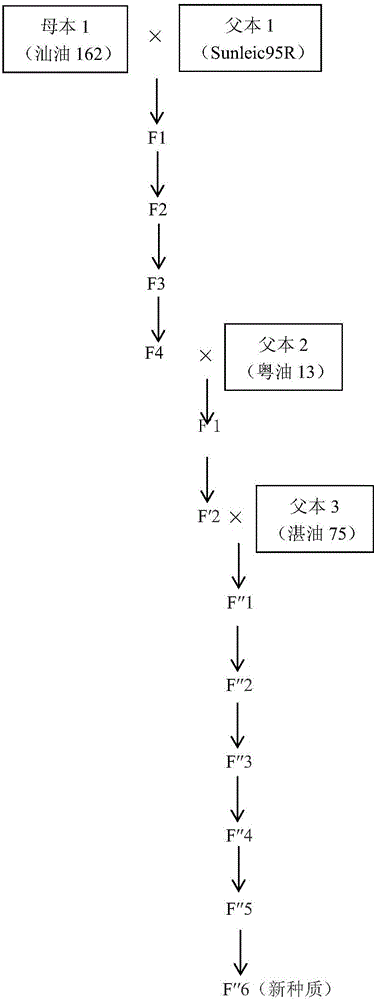Breeding method of high oleic acid peanut germplasm
A high oleic acid, peanut technology, applied in the directions of botanical equipment and methods, application, plant genetic improvement, etc., can solve the problems of unstable yield, difficult direct application, premature aging in the later stage, etc. Accurate effect
- Summary
- Abstract
- Description
- Claims
- Application Information
AI Technical Summary
Problems solved by technology
Method used
Image
Examples
Embodiment 1
[0031] A kind of breeding method of high oleic acid peanut germplasm is as follows: figure 1 As shown, the method includes the following steps:
[0032] (1) In the spring of 2003, the female parent 1 (Shanyou 162: characterized by high yield and disease resistance) and male parent 1 (SunOliec95R is a high-oleic peanut variety introduced from the United States by the applicant through the 948 project, which was tested by the Ministry of Agriculture for oil analysis. According to the central analysis, its oleic acid content is 64.14%, linoleic acid is 15.86%, and the oil / substance ratio is 4.04) for hybridization to obtain the first-generation offspring F1. In the spring of 2004, the seeds of the F1 generation were removed and the false hybrids were harvested and self-crossed to obtain F2 All single plants of the F2 generation were harvested separately; in the autumn of 2004, the seeds of the F2 generation were selfed to obtain the F3 generation, and in the spring of 2005, the s...
Embodiment 2
[0036] A kind of breeding method of high oleic acid peanut germplasm is as follows: figure 1 As shown, the method includes the following steps:
[0037] (1) In the spring of 2003, the female parent 1 (Shanyou 162: characterized by high yield and disease resistance) and male parent 1 (SunOliec95R is a high-oleic peanut variety introduced from the United States by the applicant through the 948 project, which was tested by the Ministry of Agriculture for oil analysis. According to the central analysis, its oleic acid content is 64.14%, linoleic acid is 15.86%, and the oil / substance ratio is 4.04) for hybridization to obtain the first-generation offspring F1. In the spring of 2004, the seeds of the F1 generation were removed and the false hybrids were harvested and self-crossed to obtain F2 All single plants of the F2 generation were harvested separately; in the autumn of 2004, the seeds of the F2 generation were selfed to obtain the F3 generation, and in the spring of 2005, the s...
PUM
 Login to View More
Login to View More Abstract
Description
Claims
Application Information
 Login to View More
Login to View More - R&D
- Intellectual Property
- Life Sciences
- Materials
- Tech Scout
- Unparalleled Data Quality
- Higher Quality Content
- 60% Fewer Hallucinations
Browse by: Latest US Patents, China's latest patents, Technical Efficacy Thesaurus, Application Domain, Technology Topic, Popular Technical Reports.
© 2025 PatSnap. All rights reserved.Legal|Privacy policy|Modern Slavery Act Transparency Statement|Sitemap|About US| Contact US: help@patsnap.com



